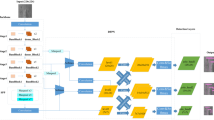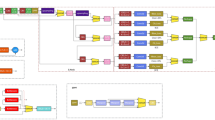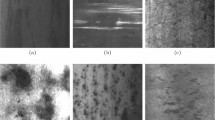Abstract
In image analysis and pattern recognition activity, one of the most salient characteristics is texture. The global region of images in spatial domain has an enhanced processing effect with the help of co-occurrence matrix and in the frequency domain for the admirable performance such as multi-scale, multi-direction local information is obtained from Gabor wavelet. The consolidation of gray-level co-occurrence matrix and Gabor wavelet is utilized to fabric image feature texture eradication. In classification phase, random decision forest (RDFs) Classifier is applied to classify the input fabric image into defective or non-defective. RDFs are a novel and outfit machine learning strategy which fuses the element choice. Nevertheless, RDFs exhibit a lot of advantages when compared with other modeling approaches within the category. The main advantages are, RDFs can handle both the continuous and discrete variables, RDFs does not overfit as a classifier, and run quick and productively when taking care of expansive datasets.
Graphical Abstract
In this paper the consolidation of gray-level co-occurrence matrix (GLCM) and Gabor wavelet is utilized to fabric image feature texture eradication. In classification phase, random decision forest (RDFs) classifier is applied to classify the input fabric image into defective or non-defective.







Similar content being viewed by others
Abbreviations
- GLCM:
-
Gray-level co-occurrence matrix
- RDFs:
-
Random decision forest
- 2D:
-
Two-dimensional
- LVQ:
-
Learning vector quantization
- GGD:
-
Generalized Gaussian density
- ML:
-
Maximum likelihood
- ANN:
-
Artificial neural network
- MRF:
-
Markov random field
- LCP:
-
Local comprehensive patterns
- ILS:
-
Isotropic lattice segmentation
- LSG:
-
Lattice segmentation assisted by Gabor filters
- MCA:
-
Morphological component analysis
- VOV:
-
Variance of variance
- LMGCP:
-
Local multi-channels Gabor comprehensive patterns
- LGMM:
-
Local Gabor magnitude map
- DDP:
-
Direction derivatives patterns
- DMP:
-
Direction magnitude patterns
- AMF:
-
Adaptive median filter
References
Bissi, L., Baruffa, G., Placidi, P., et al. (2013). Automated defect detection in uniform and structured fabrics using Gabor filters and PCA. Journal of Visual Communication and Image Representation, 24, 838–845. https://doi.org/10.1016/j.jvcir.2013.05.011.
Böttger, T., & Ulrich, M. (2016). Real-time texture error detection on textured surfaces with compressed sensing. Pattern Recognition and Image Analysis, 26, 88–94. https://doi.org/10.1134/s1054661816010053.
Cammett, M. (2007). Business-government relations and industrial change: The politics of upgrading in Morocco and Tunisia. World Development, 35, 1889–1903. https://doi.org/10.1016/j.worlddev.2007.01.003.
Clausi, D. (2012). An analysis of co-occurrence texture statistics as a function of grey level quantization. Canadian Journal of Remote Sensing, 28, 45–62. https://doi.org/10.5589/m02-004.
Deepak Sonje, M., Kundu, P., & Chowdhury, A. (2017). A novel approach for multi class fault diagnosis in induction machine based on statistical time features and random forest classifier. IOP Conference Series: Materials Science and Engineering, 225, 012141. https://doi.org/10.1088/1757-899x/225/1/012141.
Hanbay, K., Talu, M., & Özgüven, Ö. (2016). Fabric defect detection systems and methods—A systematic literature review. Optik: International Journal for Light and Electron Optics, 127, 11960–11973. https://doi.org/10.1016/j.ijleo.2016.09.110.
Hanmandlu, M., Choudhury, D., & Dash, S. (2014). Detection of defects in fabrics using topothesy fractal dimension features. Signal, Image and Video Processing, 9, 1521–1530. https://doi.org/10.1007/s11760-013-0604-5.
Jia, L., Chen, C., Liang, J., & Hou, Z. (2017). Fabric defect inspection based on lattice segmentation and Gabor filtering. Neurocomputing, 238, 84–102. https://doi.org/10.1016/j.neucom.2017.01.039.
Jia, L., & Liang, J. (2017). Fabric defect inspection based on isotropic lattice segmentation. Journal of the Franklin Institute, 354, 5694–5738. https://doi.org/10.1016/j.jfranklin.2017.05.035.
Jiang, Q., Shao, F., Jiang, G., et al. (2015). Supervised dictionary learning for blind image quality assessment using quality-constraint sparse coding. Journal of Visual Communication and Image Representation, 33, 123–133. https://doi.org/10.1016/j.jvcir.2015.09.009.
Jing, J. (2015). Automatic defect detection of patterned fabric via combining the optimal Gabor filter and golden image subtraction. Journal of Fiber Bioengineering and Informatics, 8, 229–239. https://doi.org/10.3993/jfbim00103.
Jing, J., Zhang, H., Wang, J., et al. (2013). Fabric defect detection using Gabor filters and defect classification based on LBP and Tamura method. Journal of the Textile Institute, 104, 18–27. https://doi.org/10.1080/00405000.2012.692940.
Kwon, B., Won, J., & Kang, D. (2015). Fast defect detection for various types of surfaces using random forest with VOV features. International Journal of Precision Engineering and Manufacturing, 16, 965–970. https://doi.org/10.1007/s12541-015-0125-y.
Li, Y., & Zhang, C. (2016). Automated vision system for fabric defect inspection using Gabor filters and PCNN. SpringerPlus. https://doi.org/10.1186/s40064-016-2452-6.
Li, Y., Zhao, W., & Pan, J. (2017). Deformable patterned fabric defect detection with Fisher criterion-based deep learning. IEEE Transactions on Automation Science and Engineering, 14, 1256–1264. https://doi.org/10.1109/tase.2016.2520955.
Liu, Z., Wang, J., Zhao, Q., & Li, C. (2014). A fabric defect detection algorithm based on improved valley-emphasis method. Research Journal of Applied Sciences, Engineering and Technology, 7, 2427–2431. https://doi.org/10.19026/rjaset.7.547.
Liu, Z., Yan, L., Li, C., et al. (2017). Fabric defect detection based on sparse representation of main local binary pattern. International Journal of Clothing Science and Technology, 29, 282–293. https://doi.org/10.1108/ijcst-04-2016-0040.
Kure, N. U., & Biradar, M. S. (2017). Fabric defect detection algorithm based on local neighborhood analysis. International Journal of Engineering Research and Applications.. https://doi.org/10.17577/ijertv6is040770.
Padma, A., & Giridharan, N. (2016). Performance comparison of texture feature analysis methods using PNN classifier for segmentation and classification of brain CT images. International Journal of Imaging Systems and Technology, 26, 97–105. https://doi.org/10.1002/ima.22161.
Qu, T., Zou, L., Zhang, Q., et al. (2015). Defect detection on the fabric with complex texture via dual-scale over-complete dictionary. The Journal of The Textile Institute, 107, 743–756. https://doi.org/10.1080/00405000.2015.1061760.
Rebhi, A., Benmhammed, I., Abid, S., & Fnaiech, F. (2015). Fabric defect detection using local homogeneity analysis and neural network. Journal of Photonics, 2015, 1–9. https://doi.org/10.1155/2015/376163.
Sankaran, A., Jain, A., Vashisth, T., Vatsa, M., & Singh, R. (2017). Adaptive latent fingerprint segmentation using feature selection and random decision forest classification. Information Fusion, 34, 1–15. https://doi.org/10.1016/j.inffus.2016.05.002.
Susan, S., & Sharma, M. (2017). Automatic texture defect detection using Gaussian mixture entropy modeling. Neurocomputing, 239, 232–237. https://doi.org/10.1016/j.neucom.2017.02.021.
Tabassian, M., Ghaderi, R., & Ebrahimpour, R. (2011). Knitted fabric defect classification for uncertain labels based on Dempster–Shafer theory of evidence. Expert Systems with Applications, 38, 5259–5267. https://doi.org/10.1016/j.eswa.2010.10.032.
Tao, G., Wu, X., Tan, W., & Feng, X. (2015). A novel texture description by local multi-channels Gabor comprehensive patterns. Optik: International Journal for Light and Electron Optics, 126, 2214–2218. https://doi.org/10.1016/j.ijleo.2015.05.105.
Tong, L., Wong, W., & Kwong, C. (2017). Fabric defect detection for apparel industry: A nonlocal sparse representation approach. IEEE Access. https://doi.org/10.1109/access.2017.2667890.
Tsai, D., Wu, S., & Chiu, W. (2013). Defect detection in solar modules using ICA basis images. IEEE Transactions on Industrial Informatics, 9, 122–131. https://doi.org/10.1109/tii.2012.2209663.
Tsang, C., Ngan, H., & Pang, G. (2016). Fabric inspection based on the Elo rating method. Pattern Recognition, 51, 378–394. https://doi.org/10.1016/j.patcog.2015.09.022.
Wang, C., Li, J., Chen, M., et al. (2015). The obtainment and recognition of raw silk defects based on machine vision and image analysis. The Journal of The Textile Institute, 107, 316–326. https://doi.org/10.1080/00405000.2015.1031517.
Workgroup on “Texture Analysis of DFG, “TILDA Textile Texture Database. https://lmb.informatik.uni-freiburg.de/resources/datasets/tilda.en.html. Accessed 2 Oct 2013.
Yapi, D., Allili, M., & Baaziz, N. (2018). Automatic fabric defect detection using learning-based local textural distributions in the contourlet domain. IEEE Transactions on Automation Science and Engineering, 15, 1014–1026. https://doi.org/10.1109/tase.2017.2696748.
Yapi, D., Mejri, M., Allili, M., & Baaziz, N. (2015). A learning-based approach for automatic defect detection in textile images. IFAC-PapersOnLine, 48, 2423–2428. https://doi.org/10.1016/j.ifacol.2015.06.451.
Yildiz, K. (2016). Dimensionality reduction-based feature extraction and classification on fleece fabric images. Signal, Image and Video Processing, 11, 317–323. https://doi.org/10.1007/s11760-016-0939-9.
Yuan, X., Wu, L., & Peng, Q. (2015). An improved Otsu method using the weighted object variance for defect detection. Applied Surface Science, 349, 472–484. https://doi.org/10.1016/j.apsusc.2015.05.033.
Zhang, Y., Lu, Z., & Li, J. (2010). Fabric defect classification using radial basis function network. Pattern Recognition Letters, 31, 2033–2042. https://doi.org/10.1016/j.patrec.2010.05.030.
Zhou, J., & Wang, J. (2013). Fabric defect detection using adaptive dictionaries. Textile Research Journal, 83, 1846–1859. https://doi.org/10.1177/0040517513478451.
Author information
Authors and Affiliations
Corresponding author
Rights and permissions
About this article
Cite this article
Deotale, N.T., Sarode, T.K. Fabric Defect Detection Adopting Combined GLCM, Gabor Wavelet Features and Random Decision Forest. 3D Res 10, 5 (2019). https://doi.org/10.1007/s13319-019-0215-1
Received:
Revised:
Accepted:
Published:
DOI: https://doi.org/10.1007/s13319-019-0215-1




